Ecuadorian centavo coins facts for kids
Quick facts for kids Ecuadorian centavo coins |
|
|---|---|
| ISO 4217 Code | none |
| User(s) | (alongside the U.S. dollar) |
| Pegged with | United States dollar (at 1:100 ratio) |
| Superunit | |
| 100 | United States dollar |
| Symbol | ¢ |
| Coins | 1, 5, 10, 25, 50 centavos |
| Banknotes | none issued1 |
| 1 Ecuador also uses U.S. dollar notes and the dollar coin. | |
Ecuadorian centavo coins were first used in 2000. This happened when Ecuador changed its money system from the old sucre currency to the U.S. dollar. These coins come in different values: 1, 5, 10, 25, and 50 centavos. They look and feel just like the U.S. cent coins of the same value. In Ecuador, you'll find these local centavo coins used alongside U.S. coins and paper money. It's interesting that even though U.S. $1 coins are not very common in the United States, they are used a lot in Ecuador! Ecuador does not print its own paper money; it uses U.S. dollar banknotes instead.
Contents
What Do Ecuadorian Centavo Coins Look Like?
Ecuadorian centavo coins have their number value and the value written out in Spanish. They also show the name of the Banco Central del Ecuador. On the other side, you'll see a picture and name of a famous Ecuadorian person. This side also has "República del Ecuador" and the country's coat of arms.
Special One-Cent Coin
The one-cent coin is a bit different. Instead of a person's picture, it shows a map of the Americas. It also has the words "Luz de América", which means "Light of the Americas".
Coin Materials and Dates
Most of these coins are made from nickel-plated steel. The one-cent coin is usually brass-plated steel, but some were made from copper-plated steel. The coins show the year they were made, starting from 2000. Many of the coins you see today are from that first year, 2000. These coins are made by the Royal Canadian Mint and the Casa de Moneda de México.
| Image | Value | Technical parameters | Description | Date of | ||||||
|---|---|---|---|---|---|---|---|---|---|---|
| Diameter | Thickness | Mass | Composition | Edge | Obverse | Reverse | issue | withdrawal | ||
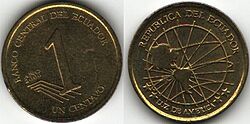 |
1 centavo | 19 mm | 1.25 mm | 2.5-2.55 g | Brass | Plain | "BANCO CENTRAL DEL ECUADOR", year of minting, denomination in digits and words | "REPUBLICA DEL ECUADOR", stylized image of the globe with the equator passing through Ecuador and rays emanating from Ecuador, legend "LUZ DE AMERICA" (Spanish for Light of the Americas) | 10 September 2000 | Current |
 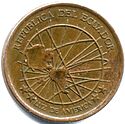 |
1 centavo | 19 mm | 1.45 mm | 2.35 g | Copper-plated steel | Plain | "BANCO CENTRAL DEL ECUADOR", year of minting, denomination in digits and words | "REPUBLICA DEL ECUADOR", stylized image of the globe showing the Americas with the equator passing through Ecuador and rays emanating from Ecuador, legend "LUZ DE AMERICA" (Spanish for Light of the Americas) | 2003 | Current |
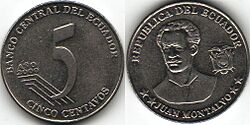 |
5 centavos | 21.2 mm | 1.9 mm | 4.95 g | Stainless steel | Plain | "BANCO CENTRAL DEL ECUADOR", year of minting, denomination in digits and words | "REPUBLICA DEL ECUADOR", portrait and name of Juan Montalvo, national coat of arms | 10 September 2000 | Current |
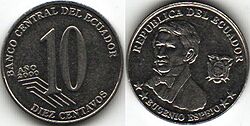 |
10 centavos | 17.9 mm | 1.3 mm | 2.3 g | Stainless steel | Reeded | "BANCO CENTRAL DEL ECUADOR", year of minting, denomination in digits and words | "REPUBLICA DEL ECUADOR", portrait and name of Eugenio Espejo, national coat of arms | 10 September 2000 | Current |
 |
25 centavos | 24.2 mm | 1.75 mm | 5.8 g | Stainless steel | Reeded | "BANCO CENTRAL DEL ECUADOR", year of minting, denomination in digits and words | "REPUBLICA DEL ECUADOR", portrait and name of José Joaquín de Olmedo, national coat of arms | 10 September 2000 | Current |
 |
50 centavos | 30.6 mm | 2.1 mm | 11.25 g | Stainless steel | Reeded | "BANCO CENTRAL DEL ECUADOR", year of minting, denomination in digits and words | "REPUBLICA DEL ECUADOR", portrait and name of Eloy Alfaro, national coat of arms | 10 September 2000 | Current |
| For table standards, see the coin specification table. | ||||||||||
What About the "Un Sucre" Coin?
The Central Bank of Ecuador also made a special $1 coin, called "un sucre". This coin was only created for special coin sets in 2000. It was never meant to be used by people in their daily shopping.
| Image | Value | Technical parameters | Description | Date of | ||||||
|---|---|---|---|---|---|---|---|---|---|---|
| Diameter | Thickness | Mass | Composition | Edge | Obverse | Reverse | issue | withdrawal | ||
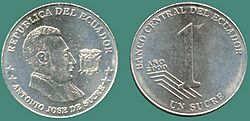 |
1 sucre | 30.5 mm | 2.2 mm | 11.25 g | Nickel-clad steel | Reeded | "BANCO CENTRAL DEL ECUADOR", year of minting, denomination in digits and words | "REPUBLICA DEL ECUADOR", portrait and name of Antonio José de Sucre, national coat of arms | 2000 (official mint sets only) | Never in circulation |
| For table standards, see the coin specification table. | ||||||||||
See Also
- Centavo - Learn more about centavo coins used around the world.
- Currency of Ecuador - Discover more about Ecuador's money.

